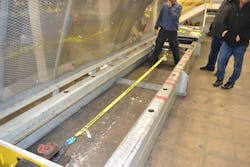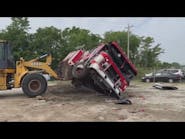Topic: Tie-down webbing
Objective: The rescue team will better understand tie-down webbing and ratchet devices used for vehicle rescue applications.
Task: The rescue team shall review their vehicle rescue ratchet strap units and determine the minimum breaking strength rating of the webbing and the working load limit for the entire assembly.
A common tool used by vehicle rescue teams is the ratchet strap device with 2-inch-wide webbing. The polyester webbing, classified by the webbing manufacturing industry as “tie-down” webbing, is used by tow and recovery operators, members of the automobile transportation industry as well as fire/rescue personnel.
Rescue crews use these devices as a tensioning to secure struts when stabilizing a vehicle. The same ratchet assembly can be used to capture the suspension at a vehicle-on-vehicle rescue incident when the heavier load is being lifted off the vehicle below.
Regardless of its application, to be most efficient and effective, personnel need to fully understand proper techniques to use the ratchet strap device and must be able to discern fact from fiction about this versatile tool.
Webbing marker lines
Polyester tie-down webbing is the norm on these devices, although nylon webbing is still available from very limited sources. The 2-inch-wide webbing used by rescue teams can be any color, but “safety yellow” is the most common. New tie-down webbing has retro-reflective threads sewn into it to further improve its visibility.
Woven within the tie-down webbing and running the length of the webbing will be either one or two brightly colored threads. Red is a very common color used with yellow webbing. These threads are the webbing marker lines. If you are using webbing that does not have any marker lines, take that tool out of service and purchase new webbing with the marker lines.
A single marker line, either solid or broken, means that the minimum tensile breaking strength of the webbing itself is 5,000 pounds per inch of webbing width—2-inch wide equals 10,000 pounds minimum breaking strength. Two marker lines means that the webbing is rated at 6,000 pounds per inch of width or 12,000 pounds minimum breaking strength for 2-inch-wide webbing. Dual lines represent the higher-rated webbing.
These marker lines do not serve any additional function other than to indicate the minimum tensile breaking strength of the webbing itself. This number is not the load rating of the ratchet assembly unit, just the webbing.
Working load limit
The term working load limit (WLL) describes the maximum load a component, or complete ratchet assembly in this case, should be subjected to during regular use. Our typical ratchet unit with 2-inch-wide webbing is generally rated with a WLL of 3,330 pounds at a 3:1 safety ratio. The webbing industry has standardized on this 3:1 safety ratio. Whenever the ratchet tool is placed in service at a rescue scene, the load on it should not exceed this 3,330 pounds WLL.
Standard hand force
To understand how to ensure that your use of a ratchet tie-down unit remains within the WLL of the tool, we reference European standard, EN 12195-2, which introduces the term “Standard Hand Force.” It represents the pulling force that can be generated by one person working the ratchet using only hand power and is approximately 1,181 pounds.
We conducted tests to see if it is possible for one person to generate a load greater than the 3,300 pounds WLL by manually cranking on the ratchet. A load cell was attached to one end of a ratchet unit placed horizontally on a test bed with no twists in the webbing. Several different individuals used only their own strength to tighten the ratchet unit as much as they possibly could. No “cheater bar” devices were permitted, only brute force hand and arm power.
In this research, 1,891 pounds was the maximum pulling force generated on the ratchet tie-down assembly—well below the 3,330 WLL of the tool. The lesson learned is that a ratchet tie-down unit at a rescue scene will not be loaded over its WLL when the ratchet is cranked as tight as humanly possible using only hand and arm power. This is important to know because we want to maintain the load on our ratchet assembly at or below the tool’s WLL for the safety of our victims and operating personnel at the scene.
Looking ahead
Next month, we review destructive tests on ratchet strap units by pulling them to failure. As they fail, we see what the weak link of a tie down ratchet strap unit really is.
SIDEBAR:
Key Terms of the Ratchet Strap Device
Marker Lines: 5,000 pounds (single line) or 6,000 pounds (dual lines) per inch of webbing width
Working Load Limit (WLL): Typical ratchet unit with 2-inch wide webbing and twin hooks has a WLL of 3,330 pounds at a 3:1 safety ratio.
Standard Hand Force: The pulling force that can be generated by one person on a ratchet device using only hand power is approximately 1,181 pounds.

Ron Moore
RON MOORE, who is a Firehouse contributing editor, recently retired as a division chief with the McKinney, TX, Fire Department and now serves with Prosper, TX, Fire Rescue. He self-published the Vehicle Rescue 1-2-3 training manual and serves as the forum moderator for the extrication section of Firehouse.com . Moore can be contacted directly at [email protected].






